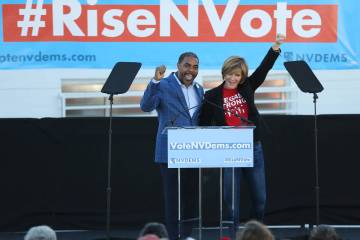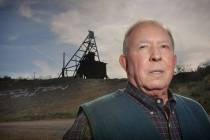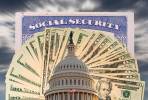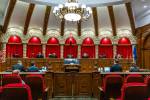Bill to change Nevada PERS sparks debate in Assembly panel
CARSON CITY — A bill seeking to change the public employees retirement system for future hires by switching to a mostly defined-contribution plan generated a lengthy debate Tuesday with government employee groups opposed and some business groups supportive.
Teacher, firefighter and police officer groups all opposed Assembly Bill 190 by Assemblyman Randy Kirner, R-Reno, to change the existing defined benefit plan to a hybrid system for new public employee hires beginning on July 1, 2016. Existing public employees would not be affected by the proposed change.
Representatives of the Reno-Sparks and Las Vegas Metro chambers endorsed the measure.
“We can’t stick our head in the sand and say that the status quo is just fine,” said Tray Abney with the Reno chamber. “It will get more expensive.”
Every dollar spent by taxpayers on the public pension plan is one less dollar that can be spent on education or mental health needs, he said.
But Ruben Murillo Jr., president of the Nevada State Education Association, said the shift to a hybrid plan could jeopardize the existing retirement plan for its 24,000 teachers and support personnel. As the shift occurs, those remaining in the defined benefit plan will see increased costs and unfunded liabilities, he said.
Such a change would make recruitment of new teachers even more difficult, Murillo said.
Opponents of the bill also brought in an expert witness, economics professor Teresa Ghilarducci with The New School, a New York university, who said 35 other states have rejected the types of changes proposed in AB190.
“Nevada has, what we call in the trade, good pension ‘hygiene,’ ” she said. “Unlike New Jersey, Rhode Island or Pennsylvania, for example, Nevada has not significantly underfunded its plan over the years.”
PERS Executive Officer Tina Leiss also spoke in opposition, saying there are numerous concerns with the bill. The current plan needs to be fully supported going forward to retire the unfunded liability even if there is a shift to a hybrid plan, she said.
Leiss also noted that the annual rate of return on the PERS plan over the past 30 years is 9.6 percent, above the projected rate of 8 percent.
The bill was heard in the Assembly Government Affairs Committee. No action was taken. If it does pass the committee, it will likely be referred to the Ways and Means Committee to discuss the financial implications of the proposed changes.
Kirner said his plan, which would maintain a smaller defined benefit element along with a defined contribution plan that would be similar to a 401(k)-type plan used in the private sector, would help eliminate a long-term unfunded liability in the existing plan of more than $12.5 billion. Nevada’s plan is currently 71 percent fully funded.
His bill would also set the retirement age for regular public employees at the same as those in Social Security, and at Social Security age minus 10 years for police and firefighters.
Currently regular employees can retire at any age with 30 years, and at age 62 with 10 years of service.
Some Republican lawmakers have long sought to make changes to the Public Employees Retirement System because of concerns that taxpayers could be forced to pay to support the plan should the unfunded liability not be eliminated over time.
The current system is a pure defined benefit plan, where retirees collect a monthly pension based primarily on salary and years of service.
A defined contribution plan would eliminate any potential taxpayer liability.
Kirner said there would still be a defined benefit element to the plan worth 6 percent of an employee’s salary that would be paid by the public agency. This piece of the plan is intended to account for the fact that Nevada public employees do not pay into Social Security, he said.
The remainder of the retirement plan would be a defined contribution plan, with 6 percent being provided by the state or local government agency and another 6 percent coming from the employee.
For police and fire, the defined contribution rate would be 9 percent each from the employer and employee.
There would also be a special assessment to help retire the long-term unfunded liability for the retirement plan as it exists now for current public sector workers.
Contact Sean Whaley at swhaley@reviewjournal.com or 775-687-3900. Find him on Twitter: @seanw801.

RELATED STORIES
Bill would repeal Adam Walsh sex-offender act in Nevada
Nevada assemblyman arrested on DUI charge
North Las Vegas leads charge to empower cities
Bill introduced to change Nevada overtime law
Nevada bill to change vehicle smog-testing draws opposition
Sandoval signs bill to reform Nevada construction defect law
Nevada legislators will not take up same-sex marriages, citing court rulings
See all of our coverage: 2015 Nevada Legislature.




























